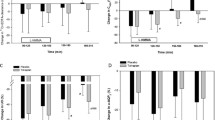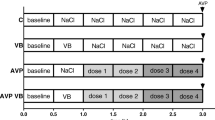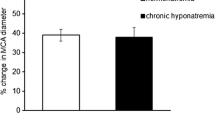Summary
Previous investigations suggest that in a normotensive organism the vasopressor effect of 8-arginine-vasopressin (AVP) is very effectively buffered by cardiovascular reflex mechanisms. Exogenous AVP administration shows only small, transient increases in blood pressure in spite of continued AVP-infusion and high plasma AVP concentrations. The present study aims to clarify the mechanism of the observed transient blood pressure elevations which are often referred to as “tachyphylaxis”.
Our results in healthy subjects show a two phase response to exogenous AVP: an initial phase which is characterized by cardiac reflex mechanisms and a second phase during which a normalisation of the elevated total peripheral resistance occurs. Inhibition of prostaglandin synthesis with indomethacin almost completely attenuates this vascular counterregulation to exogenous AVP, thus providing evidence that a prostaglandin mediated vasodilation in response to AVP may be the underlying mechanism for “vasopressin tachyphylaxis”. The role of the renin-angiotensin-system and the importance of different regional hemodynamic effects of AVP are discussed.
Zusammenfassung
Bisher vorliegende Untersuchungen lassen vermuten, daß in einem normotensiven Organismus der vasopressorische Effekt von 8-Arginin-Vasopressin (AVP) effektiv durch cardiovaskuläre Reflexe abgeschwächt wird. Die Gabe von exogenem AVP führt zu nur vorübergehenden Pressorreaktionen trotz fortgeführter ADH-Infusion und deutlich erhöhter Plasma-AVP-Konzentrationen. Die vorliegende Untersuchung versucht den Mechanismus der nur vorübergehenden Blutdruckerhöhungen, die oft als “Tachyphylaxie” bezeichnet werden, weiter zu charakterisieren.
Unsere Ergebnisse bei gesunden Versuchspersonen zeigen einen zweiphasigen Verlauf nach i.v. Gabe von AVP: eine initiale Phase, die durch cardiovaskuläre Reflexe gekennzeichnet ist und eine zweite Phase, während der sich der periphere Gefäßwiderstand normalisiert. Hemmung der Prostaglandin-Synthese mit Indomethacin schwächt die vaskuläre Gegenregulation auf exogenes AVP ab und läßt so eine prostaglandinvermittelte Vasodilatation als Reaktion auf AVP als Ursache der „Vasopressintachyphylaxie“ vermuten. Die Bedeutung des Renin-Angiotensin-Systems und unterschiedlicher regionaler hämodynamischer Effekte von AVP werden diskutiert.
Similar content being viewed by others
References
Altura BM, Altura BT (1977) Vascular smooth muscle and neurohypophyseal hormones. Fed Proc 36:1853–1860
Bunag RD, Page IH, McCubbin JW (1967) Inhibition of renin release by vasopressin and angiotensin. Cardiovasc Res 1:67–73
Cowley AW, Monos E, Guyton AC (1974) Interaction of vasopressin and the baroreceptor reflex system in the regulation of arterial blood pressure in the dog. Circ Res 34:505–514
Cowley AW, Switzer SJ, Guinn MM (1980) Evidence and quantification of the vasopressin arterial blood pressure control system in the dog. Circ Res 46:58–67
Emerson TE Jr (1966) Effects of angiotensin, epinephrine, norepinephrine, and vasopressin on venous return. Am J Physiol 210:933–942
Glänzer K, Appenheimer M, Vetter H (1982) Radioimmunoassay of AVP in human plasma: development and applications. (Manuscript in preparation)
Haber E, Koerner T, Page LB, Kliman B, Purnode A (1969) Application of a radioimmunoassay for angiotensin I to the physiologic measurements of plasma renin activity in normal human subjects. J Clin Endocr Metab 29:1349–1355
Henderson IW, Balment RJ, Oliver JA (1978) Vasopressin effects on plasma renin activity in male and female rats. Clin Sci 55:301–307
Hoffman WE (1980) Regional vascular effects of antidiuretic hormone in normal and sympathetic blocked rats. Endocrinology 107:334–341
Kerr JC, Hobson RW, Seelig RF, Swan KG (1978) Vasopressin: Route of administration and effects on canine hepatic and superior mesenteric arterial blood flows. Ann Surg 187:137–142
Khokhar, AM, Slater JDH, Ma J, Ramage CM (1980) The cardiovascular effects of vasopressin in relation to its plasma concentration in man and its relevance to high blood pressure. Clin Endocrin 13:259–266
Khokhar AM, Slater JDH, Forsling ML, Payne NN (1976) Effect of vasopressin on plasma volume and renin release in man. Clin Sci 50:415–424
Kubicek WG, Patterson RP, Lillehei RC, From AHL, Castaneda I, Ersek R (1970) Impedance cardiography as a non-invasive means to monitor cardiac function. J Amer Assoc for Adv Med Instrumentation 4:79–84
LaRochelle FT, North WG, Stern P (1980) A new extraction of arginine vasopressin from blood: the use of octadecasilylsilica. Pflügers Arch 387:79–81
Larsson C, Weber PC, Anggard E (1974) Arachidonic acid increases and indomethacin decreases plasma renin activity in the rabbit. Europ J Pharmacol 28:391–394
Monos E, Cox RH, Peterson LH (1978) Direct effects of physiological doses of arginine vasopressin on the arterial wall in vivo. Am J Physiol H 167–172
Montani JP, Liard JF, Schoun J, Möhring J (1980) Hemodynamic effects of exogenous and endogenous vasopressin at low plasma concentrations in conscious dogs. Circ Res 47:346–355
Möhring B, Möhring J (1975) Plasma ADH in mormal Long-Evans rats and in Long-Evans rats heterozygous and homozygous for hypothalamic diabetes insipidus. Life Sci 17:1307–1314
Möhring J, Glänzer K, Maciel JA Jr, Düsing R, Kramer HJ, Arbogast R, Koch-Weser J (1980) Greatly enhanced pressor response to antidiuretic hormone in patients with impaired cardiovascular reflexes due to idiopathic orthostatic hypotension. J Cardiovasc Pharm 2:367–376
Nakano J (1974) Cardiovascular responses to neurohypophyseal hormones. In: Handbook of Physiology, Amer Physiol Soc, Sec 7, Vol 4, pp 395–442
Oliver G, Schäfer EA (1895) On the physiological action of extracts of pituitary body and certain other glandular organs. J Physiol 18:277–279
Padfield PL, Jehoida MB, Brown J, Lever AF, Morton JJ, Robertson JIS (1981) Blood pressure in acute and chronic vasopressin excess. New Engl J Med 304:1067–1070
Philbin DM, Coggins CH, Wilson N, Sokolowski J (1977) Anti-diuretic hormone levels during cardiopulmonary bypass. J Cardiovasc Surg 145–148
Schmid PG, Abboud FM, Wendling MG, Ramberg ES, Mark AL, Heistad DD, Eckstein JW (1974) Regional vascular effects of vasopressin: plasma levels and circulatory response. Am J Physiol 227:998–1004
Shy GM, Drager GA (1960) A neurological syndrome associated with orthostatic hypotension. AMA Arch Neurol 2:511–527
Smith MJ, Cowley AW, Guyton AC, Manning RD (1979) Acute and chronic effects of vasopressin on blood pressure, electrolytes, and fluid volumes. Am J Physiol 237:F232-F240
Szcepanska-Sadowska E (1973) Hemodynamic effects of a moderate increase of the plasma vasopressin level in conscious dogs. Pflügers Arch 338:313–322
Vander AJ (1968) Inhibition of renin release in the dog by vasopressin and vasotocin. Circ Res 23:605–609
Wagner HN, Braunwald E (1956) The pressor effect of the antidiuretic principle of the posterior pituitary in orthostatic hypotension. J Clin Invest 35:1412–1418
Weinstein H, Berne RM, Sachs H (1960) Vasopressin in blood: effect of hemorrhage. Endocrinology 66:712–718
Wennmalm A (1978) Influence of indomethacin on the systemic and pulmonary vascular resistance in man. Cli Sci 54:141–145
Author information
Authors and Affiliations
Additional information
Dedicated to Professor F. Krück on the occasion of his 60th birthday
Supported by Ministerium für Wissenschaft und Forschung NRW Grant Nr.: FA 8871 and Herbert Reeck-Stiftung Bonn
Rights and permissions
About this article
Cite this article
Glänzer, K., Prüßing, B., Düsing, R. et al. Hemodynamic and hormonal responses to 8-arginine-vasopressin in healthy man: Effects of indomethacin. Klin Wochenschr 60, 1234–1239 (1982). https://doi.org/10.1007/BF01716729
Issue Date:
DOI: https://doi.org/10.1007/BF01716729




